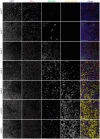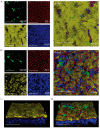Porcine Airway Organoid-Derived Well-Differentiated Epithelial Cultures as a Tool for the Characterization of Swine Influenza a Virus Strains
- PMID: 39599891
- PMCID: PMC11598950
- DOI: 10.3390/v16111777
Porcine Airway Organoid-Derived Well-Differentiated Epithelial Cultures as a Tool for the Characterization of Swine Influenza a Virus Strains
Abstract
Swine influenza A viruses (IAVsw) are important causes of disease in pigs but also constitute a public health risk. IAVsw strains show remarkable differences in pathogenicity. We aimed to generate airway organoids from the porcine lower respiratory tract and use these to establish well-differentiated airway epithelial cell (WD-AEC) cultures grown at an air-liquid interface (ALI) for in vitro screening of IAVsw strain virulence. Epithelial cells were isolated from bronchus tissue of juvenile pigs, and airway organoids were cultured in an extracellular matrix in a culture medium containing human growth factors. Single-cell suspensions of these 3D organoids were seeded on Transwell filters and differentiated at ALI to form a pseudostratified epithelium containing ciliated cells, mucus-producing cells and tight junctions. Inoculation with a low dose of IAVsw in a low volume inoculum resulted in virus replication without requiring the addition of trypsin, and was quantified by the detection of viral genome loads in apical washes. Interestingly, inoculation of an H3N2 strain known to cause severe disease in pigs induced a greater reduction in trans-epithelial resistance and more damage to tight junctions than H1N2 or H1N1 strains associated with mild disease in pigs. We conclude that the porcine WD-AEC model is useful in assessing the virulence of IAVsw strains.
Keywords: Transwell cultures; airway epithelial cells; air–liquid interface; organoids; pig; swine influenza virus.
Conflict of interest statement
The authors declare no conflicts of interest. The funders had no role in the design of the study; in the collection, analyses, or interpretation of data; in the writing of the manuscript; or in the decision to publish the results.
Figures




Similar articles
-
Replication characteristics of swine influenza viruses in precision-cut lung slices reflect the virulence properties of the viruses.Vet Res. 2013 Nov 13;44(1):110. doi: 10.1186/1297-9716-44-110. Vet Res. 2013. PMID: 24225030 Free PMC article.
-
The evolution, pathogenicity and transmissibility of quadruple reassortant H1N2 swine influenza virus in China: A potential threat to public health.Virol Sin. 2024 Apr;39(2):205-217. doi: 10.1016/j.virs.2024.02.002. Epub 2024 Feb 10. Virol Sin. 2024. PMID: 38346538 Free PMC article.
-
Evolution and Pathogenicity of the H1 and H3 Subtypes of Swine Influenza Virus in Mice between 2016 and 2019 in China.Viruses. 2020 Mar 9;12(3):298. doi: 10.3390/v12030298. Viruses. 2020. PMID: 32182849 Free PMC article.
-
[Swine influenza virus: evolution mechanism and epidemic characterization--a review].Wei Sheng Wu Xue Bao. 2009 Sep;49(9):1138-45. Wei Sheng Wu Xue Bao. 2009. PMID: 20030049 Review. Chinese.
-
Swine influenza viruses: an Asian perspective.Curr Top Microbiol Immunol. 2013;370:147-72. doi: 10.1007/82_2011_195. Curr Top Microbiol Immunol. 2013. PMID: 22266639 Review.
References
Publication types
MeSH terms
Grants and funding
LinkOut - more resources
Full Text Sources

